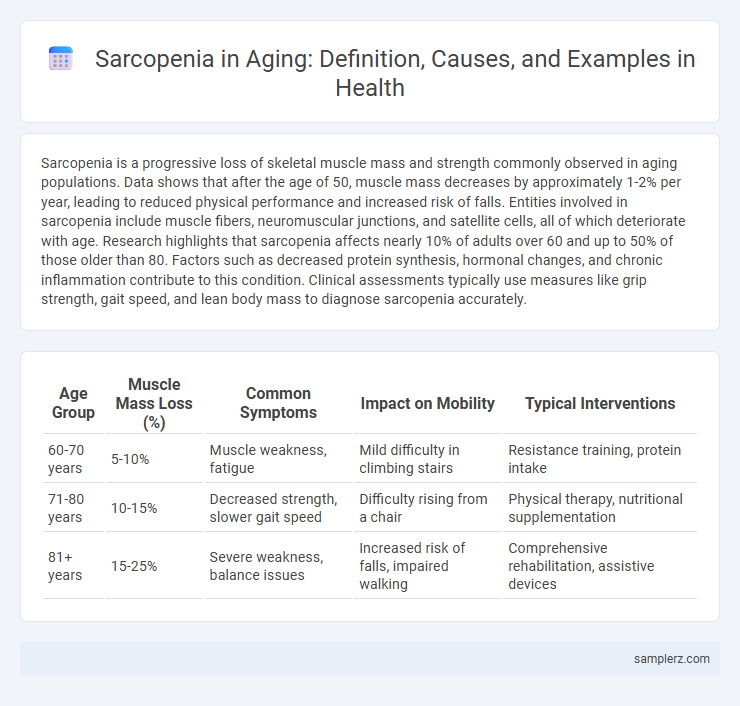Sarcopenia is a progressive loss of skeletal muscle mass and strength commonly observed in aging populations. Data shows that after the age of 50, muscle mass decreases by approximately 1-2% per year, leading to reduced physical performance and increased risk of falls. Entities involved in sarcopenia include muscle fibers, neuromuscular junctions, and satellite cells, all of which deteriorate with age. Research highlights that sarcopenia affects nearly 10% of adults over 60 and up to 50% of those older than 80. Factors such as decreased protein synthesis, hormonal changes, and chronic inflammation contribute to this condition. Clinical assessments typically use measures like grip strength, gait speed, and lean body mass to diagnose sarcopenia accurately.
Table of Comparison
| Age Group | Muscle Mass Loss (%) | Common Symptoms | Impact on Mobility | Typical Interventions |
|---|---|---|---|---|
| 60-70 years | 5-10% | Muscle weakness, fatigue | Mild difficulty in climbing stairs | Resistance training, protein intake |
| 71-80 years | 10-15% | Decreased strength, slower gait speed | Difficulty rising from a chair | Physical therapy, nutritional supplementation |
| 81+ years | 15-25% | Severe weakness, balance issues | Increased risk of falls, impaired walking | Comprehensive rehabilitation, assistive devices |
Introduction to Sarcopenia in Aging
Sarcopenia, characterized by the progressive loss of skeletal muscle mass and strength, significantly affects older adults, leading to decreased mobility and increased risk of falls. Age-related muscle degeneration results from factors such as hormonal changes, inflammation, and reduced physical activity. Early identification and targeted interventions are essential to mitigate sarcopenia's impact on functional independence in the elderly population.
Key Causes of Sarcopenia Among Older Adults
Sarcopenia, characterized by the progressive loss of muscle mass and strength, primarily results from age-related hormonal changes such as decreased levels of testosterone and growth hormone. Nutritional deficiencies, particularly inadequate protein intake and vitamin D insufficiency, significantly contribute to muscle deterioration in older adults. Chronic inflammation and reduced physical activity exacerbate muscle atrophy, increasing the risk of frailty and falls among the elderly.
Early Signs and Symptoms of Sarcopenia
Early signs of sarcopenia in aging include noticeable muscle weakness, reduced endurance during physical activities, and difficulty performing daily tasks such as climbing stairs or carrying groceries. Muscle mass loss often manifests as decreased muscle size and increased fatigue, which can lead to impaired balance and a higher risk of falls. Monitoring grip strength and walking speed are key indicators used by healthcare professionals to detect sarcopenia in its initial stages.
Diagnostic Criteria for Age-Related Sarcopenia
Age-related sarcopenia is diagnosed primarily through assessments of muscle mass, muscle strength, and physical performance. Diagnostic criteria often include appendicular lean muscle mass measured by dual-energy X-ray absorptiometry (DXA), handgrip strength thresholds below 27 kg in men and 16 kg in women, and gait speed less than 0.8 m/s over 4 meters. Early and accurate diagnosis using these criteria enables targeted interventions to prevent disability and improve quality of life in older adults.
Real-Life Examples of Sarcopenia in Seniors
Sarcopenia commonly presents in seniors as a marked decline in muscle strength and mass, leading to difficulties in daily activities such as climbing stairs or carrying groceries. For example, an 80-year-old individual may experience frequent falls due to weakened leg muscles and impaired balance, illustrating the real-life impact of sarcopenia on mobility. Physical therapy and resistance training have shown effectiveness in mitigating these symptoms and improving seniors' quality of life.
Impact of Sarcopenia on Daily Activities and Independence
Sarcopenia, characterized by progressive loss of muscle mass and strength, significantly impairs daily activities such as walking, climbing stairs, and carrying objects in older adults. This condition increases the risk of falls and fractures, leading to decreased independence and higher rates of disability among the elderly population. Effective management through resistance training and adequate protein intake is essential to mitigate functional decline and preserve quality of life.
Risk Factors Contributing to Sarcopenia in the Elderly
Chronic inflammation, physical inactivity, and inadequate protein intake are significant risk factors contributing to sarcopenia in the elderly. Hormonal changes, such as decreased testosterone and growth hormone levels, exacerbate muscle loss and functional decline. Comorbidities like diabetes and obesity further increase the susceptibility to sarcopenia by impairing muscle metabolism and regeneration.
Prevention Strategies for Age-Related Sarcopenia
Regular resistance training exercises significantly improve muscle mass and strength, effectively counteracting age-related sarcopenia. Adequate protein intake, particularly leucine-rich sources, supports muscle protein synthesis and aids in maintaining muscle functionality. Vitamin D supplementation combined with physical activity reduces inflammation and enhances muscle health in elderly populations.
Evidence-Based Treatments for Sarcopenia in Aging
Resistance training significantly improves muscle mass and strength in older adults with sarcopenia, as demonstrated by multiple randomized controlled trials. Nutritional supplementation, particularly with protein and vitamin D, enhances muscle protein synthesis and functional outcomes. Pharmacologic interventions such as selective androgen receptor modulators (SARMs) are emerging but require further clinical validation for efficacy and safety.
Future Trends in Managing Sarcopenia Among Older Adults
Emerging therapies for managing sarcopenia in older adults include personalized exercise regimens combined with novel pharmacological agents targeting muscle regeneration and inflammation reduction. Advances in biomarker identification and genetic profiling enable early detection and tailored interventions to optimize muscle mass preservation. Integration of digital health technologies such as wearable devices and telehealth platforms enhances continuous monitoring and individualized care, improving functional outcomes and quality of life for aging populations.

example of sarcopenia in aging Infographic
 samplerz.com
samplerz.com